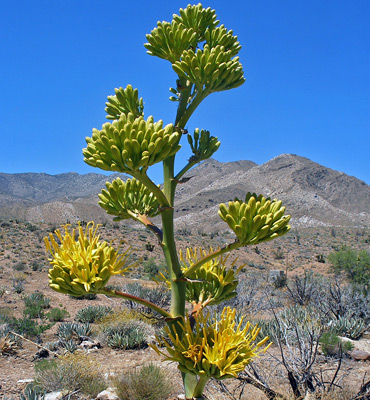Agave and yucca belong to the same subfamily (agavoideae) and have a similar appearance, with long, thin leaves bearing a sharp point at the end, radiating from a central stem to form a symmetric rosette.
The main distinguishing features are that yucca have leaves which are narrower, thinner, less tapering, do not have spines along the edges but often bear thin, curly white hairs instead. Agave leaves are generally wider, thicker, more tapering (lanceolate), are often edged by spines but do not have thin hairs.
Agave flowers are mostly yellow and are borne at the top of a tall stalk, some way above the plant, while yucca flowers tend to be white and grow on a shorter stalk, closer to the rosette. Yucca flower many times, agave only once, after which the plant dies. Yucca often branch, growing tall and tree like - the best example is yucca brevifolia, the distinctive Joshua tree of the Mojave Desert, while agave are always low growing and solitary, though new plants sprout from the root system.
Also in the Southwest are several similar rosette-forming desert species including sotol and nolina.
Agave and Yucca
Agave
Agave are succulent plants, meaning their leaves retain water and hence are thick and fleshy. Leaves radiate from a short central stem are protected by a long spine at the tip and (usually) by rows of equally sharp spines along the edges. Plants favor desert environments, especially in Mexico, but the range extends across south and southwest USA, where just over 20 species are found, out of a total of over 200. Agave are sometimes known as century plants owing to their habit of flowering only once, when aged; flowers are borne along the upper portion of a tall stalk that in some species reaches a height of 30 feet.
Yucca
Yucca are characterized by dense rosettes of narrow, thin, closely-spaced leaves, often edged by short, white, curling hairs. The leaf tip may have a spine but this is less sharp than on agave plants. There are 27 US species, much more widely distributed than agave, ranging across the Midwest, Great Plains and all the eastern states in addition to the south, in mixed environments including deserts, grassland, mountains and coastal scrub. They also extend through Mexico towards Central America.
All species have the capability to grow tall and branch, though in some arid locations this does not happen, and the plants remain compact and single. Flowers are white and bell-shaped, growing in a great mass on a shortish stalk; they are usually produced once a year though may not appear if weather conditions are unfavorable.
Other Species
There are several other rosette-forming plants of the Southwest deserts that resemble agave and yucca. Most widespread is nolina (beargrass), which has leaves that are thinner, straighter, less rigid and more numerous. There are 14 US species.
Dasylirion (sotol) is a similar plant, notable for a row of tiny teeth along each leaf; it produces tall flower stalks, similar to an agave. Other yucca-like species include hechtia texensis (Texas false agave).
The main distinguishing features are that yucca have leaves which are narrower, thinner, less tapering, do not have spines along the edges but often bear thin, curly white hairs instead. Agave leaves are generally wider, thicker, more tapering (lanceolate), are often edged by spines but do not have thin hairs.
Agave flowers are mostly yellow and are borne at the top of a tall stalk, some way above the plant, while yucca flowers tend to be white and grow on a shorter stalk, closer to the rosette. Yucca flower many times, agave only once, after which the plant dies. Yucca often branch, growing tall and tree like - the best example is yucca brevifolia, the distinctive Joshua tree of the Mojave Desert, while agave are always low growing and solitary, though new plants sprout from the root system.
Also in the Southwest are several similar rosette-forming desert species including sotol and nolina.
Agave and Yucca
Agave
 |
Yucca
 |
All species have the capability to grow tall and branch, though in some arid locations this does not happen, and the plants remain compact and single. Flowers are white and bell-shaped, growing in a great mass on a shortish stalk; they are usually produced once a year though may not appear if weather conditions are unfavorable.
Other Species
 |
Dasylirion (sotol) is a similar plant, notable for a row of tiny teeth along each leaf; it produces tall flower stalks, similar to an agave. Other yucca-like species include hechtia texensis (Texas false agave).
All Contents © Copyright The American Southwest | Comments and Questions | Contribute | Affiliate Marketing Disclosure | Site Map


